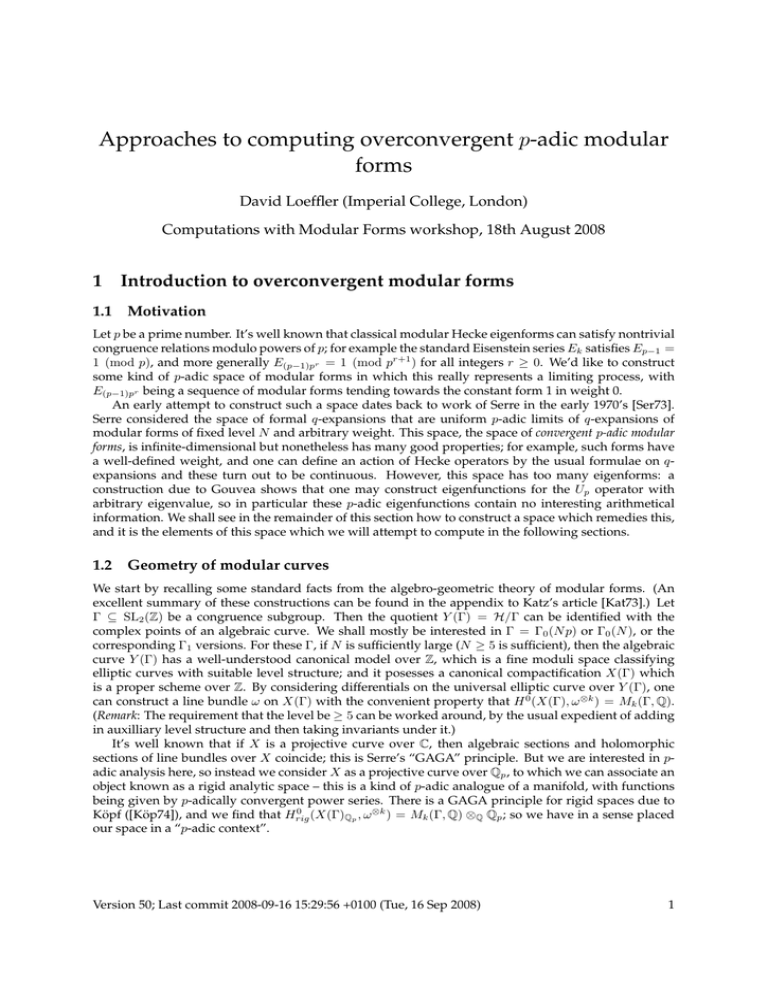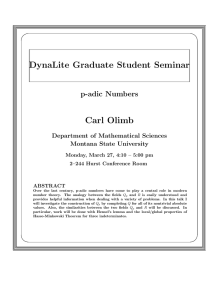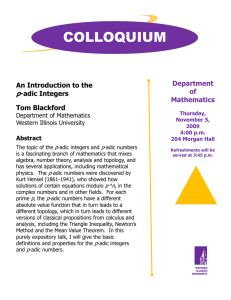Approaches to computing overconvergent p-adic modular forms 1 Introduction to overconvergent modular forms
advertisement

Approaches to computing overconvergent p-adic modular
forms
David Loeffler (Imperial College, London)
Computations with Modular Forms workshop, 18th August 2008
1
1.1
Introduction to overconvergent modular forms
Motivation
Let p be a prime number. It’s well known that classical modular Hecke eigenforms can satisfy nontrivial
congruence relations modulo powers of p; for example the standard Eisenstein series Ek satisfies Ep−1 =
1 (mod p), and more generally E(p−1)pr = 1 (mod pr+1 ) for all integers r ≥ 0. We’d like to construct
some kind of p-adic space of modular forms in which this really represents a limiting process, with
E(p−1)pr being a sequence of modular forms tending towards the constant form 1 in weight 0.
An early attempt to construct such a space dates back to work of Serre in the early 1970’s [Ser73].
Serre considered the space of formal q-expansions that are uniform p-adic limits of q-expansions of
modular forms of fixed level N and arbitrary weight. This space, the space of convergent p-adic modular
forms, is infinite-dimensional but nonetheless has many good properties; for example, such forms have
a well-defined weight, and one can define an action of Hecke operators by the usual formulae on qexpansions and these turn out to be continuous. However, this space has too many eigenforms: a
construction due to Gouvea shows that one may construct eigenfunctions for the Up operator with
arbitrary eigenvalue, so in particular these p-adic eigenfunctions contain no interesting arithmetical
information. We shall see in the remainder of this section how to construct a space which remedies this,
and it is the elements of this space which we will attempt to compute in the following sections.
1.2
Geometry of modular curves
We start by recalling some standard facts from the algebro-geometric theory of modular forms. (An
excellent summary of these constructions can be found in the appendix to Katz’s article [Kat73].) Let
Γ ⊆ SL2 (Z) be a congruence subgroup. Then the quotient Y (Γ) = H/Γ can be identified with the
complex points of an algebraic curve. We shall mostly be interested in Γ = Γ0 (N p) or Γ0 (N ), or the
corresponding Γ1 versions. For these Γ, if N is sufficiently large (N ≥ 5 is sufficient), then the algebraic
curve Y (Γ) has a well-understood canonical model over Z, which is a fine moduli space classifying
elliptic curves with suitable level structure; and it posesses a canonical compactification X(Γ) which
is a proper scheme over Z. By considering differentials on the universal elliptic curve over Y (Γ), one
can construct a line bundle ω on X(Γ) with the convenient property that H 0 (X(Γ), ω ⊗k ) = Mk (Γ, Q).
(Remark: The requirement that the level be ≥ 5 can be worked around, by the usual expedient of adding
in auxilliary level structure and then taking invariants under it.)
It’s well known that if X is a projective curve over C, then algebraic sections and holomorphic
sections of line bundles over X coincide; this is Serre’s “GAGA” principle. But we are interested in padic analysis here, so instead we consider X as a projective curve over Qp , to which we can associate an
object known as a rigid analytic space – this is a kind of p-adic analogue of a manifold, with functions
being given by p-adically convergent power series. There is a GAGA principle for rigid spaces due to
0
Köpf ([Köp74]), and we find that Hrig
(X(Γ)Qp , ω ⊗k ) = Mk (Γ, Q) ⊗Q Qp ; so we have in a sense placed
our space in a “p-adic context”.
Version 50; Last commit 2008-09-16 15:29:56 +0100 (Tue, 16 Sep 2008)
1
1.3
Butchered modular curves
An insight due to Katz is that the “bad points” of X(Γ) are those corresponding to elliptic curves with
supersingular reduction modulo p; if the congruence of q-expansions Ep−1 = 1 (mod p) is to be given
a geometric interpretation, then points where Ep−1 vanishes modulo p are troublesome.
In the rigid space associated to X(Γ), these supersingular points are a well-behaved rigid subspace,
isomorphic to a finite union of open p-adic discs corresponding to the supersingular j-invariants in
characteristic p. Hence one can construct the complement of these discs as a rigid space, which is
denoted X(Γ)ord (the ordinary locus).
0
Theorem (Katz). The space Hrig
(X(Γ)ord , ω ⊗k ) is isomorphic (as a Banach space and as a Hecke module) to
Serre’s space of convergent p-adic modular forms.
This shows that we are on the right track, but we have been a little too drastic in throwing away the
whole discs – we have found ourselves in a space that is too large. So we try throwing away smaller subdiscs; but one must do this in some reasonably canonical manner (so that the resulting space is stable
under the correspondences on X(Γ) that give Hecke operators). So we run in to the usual problem that
discs in ultrametric spaces don’t know where their centres are.
Fortunately, there is a solution. The mod p Hasse invariant, a modular form over Fp of weight p − 1
which is zero precisely at supersingular points, can be lifted to a characteristic 0 form defined over Qp ;
for example, if p ≥ 5 the level 1 Eisenstein series is such a lift. Katz shows that if A is such a lifting, and x
is a point of X(Γ)(Qp ) such that ordp A(x) < 1, then this number ordp A(x) is independent of the choice
of A. So if 0 < r < 1, defining X(Γ)≤r to be the set of x such that ordp A(x) ≤ r, we obtain a well-defined
p
this space is stable under the Hecke
rigid subspace of X(Γ). Katz moreover shows that if r < p+1
0
correspondences; hence the space Hrig
(X(Γ)≤r , ω ⊗k ) gives a space with a continuous Hecke action.
This is the space of r-overconvergent p-adic modular forms, denoted Mk† (Γ, r). Finally, on this space
the Hecke operator Up is compact – in fact this follows from the fact that it increases overconvergence,
so if f is r-overconvergent Up f will be pr-overconvergent – so we have a good spectral theory. This is
the space we shall attempt to compute.
(A more detailed introduction to this theory can be found in Emerton’s survey article [Eme].)
2
Explicit parametrisation
The first algorithm we shall discuss is based on work of several authors including Emerton, Smithline,
Buzzard and Calegari; a detailed description and some tables of results can be found in my paper
[Loe07].
If Γ = SL2 (Z), then X(Γ) is isomorphic to P1 . If p is sufficiently small, then there is only one
supersingular j-invariant, so for any r, X(Γ)≤r will be the complement in P1 of an open disc, which is
simply a closed disc. So the space of functions on X(Γ)≤r can be written down explicitly. This works
for p in the set {2, 3, 5, 7, 13}.
1/(p−1)
We shall define an explicit uniformiser as follows. Let f be the function ∆(pz)
. This is a
∆(z)
p
function on X0 (p); but Katz’s theory of the canonical subgroup shows that for r < p+1
, the forgetful
≤r
map X0 (p) → X0 (1) has a rigid-analytic section over X0 (1) , identifying it with X0 (p)≤r . One can
show explicitly that X0 (p)≤r is precisely the region of X0 (p) where ordp f ≥ −12r
p−1 .
Hence the space of rigid functions on X0 (1)≤r is the space of power series
nX
o
12rn
an f n an ∈ Qp , ordp (an ) −
→ +∞ .
p−1
n≥0
This space is, by definition, M0† (SL2 (Z), r); and if Ek∗ represents the level p Eisenstein series of weight
k whose Up -eigenvalue is 1, then (by a theorem of Coleman) Ek∗ is overconvergent with no zeros on
X0 (p)≤r , and hence Mk† (SL2 (Z), r) is simply Ek∗ · M0† (SL2 (Z), r). (In particular, Mk† and M0† are isomorphic as abstract Banach spaces; but the Hecke actions on the two are different.)
So we would like to compute the matrix of the Up operator in this basis; equivalently, we want to
write (Ek∗ )−1 · Up (f j Ek∗ ) as a convergent power series in f . In principle we can calculate this directly
Version 50; Last commit 2008-09-16 15:29:56 +0100 (Tue, 16 Sep 2008)
2
from the q-expansion – since the q-expansion of f has no constant term, the first n coefficients of the
q-expansion of Up (f j Ek∗ ) determine the first n entries of the corresponding column of the matrix. However, computing many terms of the matrix this way is prohibitively expensive.
A more practical method relies on a cunning observation due originally to an obscure Norwegian
author named Kolberg [Kol61]. In terms of q-expansions,
Up (f j Ek∗ )(q) = (f j Ek∗ )(q 1/p ) + (f j Ek∗ )(ζp · q 1/p ) + · · · + (f j Ek∗ )(ζpp−1 · q 1/p );
so if k and q are fixed, Up (fj Ek∗ ) will satisfy a recurrence of degree p in j, with coefficients that are the
elementary symmetric functions of the set {f (q 1/p ), . . . , f (ζpp−1 · q 1/p )}.
Lemma (Kolberg). These are all polynomials in f of degree at most p.
This motivates the choice of function f . (For a “random” uniformiser, one would expect them to be
rational functions of f , but the fact that f is an η-product constrains the denominators to be trivial.) For
example, if p = 2 then we find that Up (f j Ek∗ ) = (48f + 211 f 2 )Up (f j−1 Ek∗ ) + f Up (f j−2 Ek∗ ).
This recurrence allows the entire matrix of Up on Mk† (Γ, r), for any given r and k, to be computed
very rapidly using only integer arithmetic, given only its first p rows and columns. Since this matrix
represents a compact operator for r in the appropriate range, we may truncate it to an N × N top left
submatrix and calculate the eigenvalues and eigenvectors of this truncated matrix; these will converge
rapidly to the eigenvectors of Up with small slope (p-adic valuation of the eigenvalue). Converting
the f -adic expansions of these back to q-expansions it is also easy to read off the action of the Hecke
operators at other primes ` 6= p, so one has an essentially complete description of Mk† .
(Remark: If p is 11, 17 or 19, then there are two supersingular j-invariants and a similar idea can
be made to work: the overconvergent locus is no longer a disc but an annulus, so one is forced to use
Laurent series in place of power series. However, there is no analogue of the uniformiser f and the
associated recurrence formula, so calculating the Hecke action is harder, but still possible; this has been
implemented by Lloyd Kilford. For primes ≥ 23 it is not clear how to proceed.)
3
The p-adic trace formula
The second algorithm we shall use, which I learnt from Frank Calegari, gives less information but in a
much wider range of cases.
There is a classical formula, due to Eichler, which gives the trace of the Hecke operator Tm acting on
Sk (Γ0 (N )) (originally assuming N is square-free). This was subsequently generalised vastly by Selberg
and others to give a whole industry of trace formulae for many different kinds of automorphic forms;
but we shall use only Eichler’s original formula, and a generalisation by Hijikata to handle the case
where N is not square-free.
The dependency on m and N is subtle, involving a sum over factorisations of m in all possible
imaginary quadratic fields, but for a fixed m and N it depends on k only through a finite sum of terms
of the form ρk−1 , where ρ is an algebraic integer constant. For example, Tr(T2 |Sk (SL2 Z)) is given by
−
(1 +
√
−1)
k−1
− (1 −
√
4 −1
√
−1)
k−1
−
k−1
√
1+ −7
2
√ k−1
√ k−1
− 1− 2 −7
−2
√
−
− 1.
2
−7
Let p be a fixed prime, and N some arbitrary level with p - N . Fix an integer k∞ and consider a
cunningly chosen sequence of integers kn satisfying the following conditions:
• kn = k∞ (mod p − 1) for all n (or mod 2 if p = 2)
• kn → ∞ in R
• kn → k∞ in Zp
In the trace formula for Tr(Tp |Sk (Γ0 (N ))), whenever there is a term ρk−1 with the p-adic valuation
of ρ positive, ρkn −1 will tend rapidly to zero p-adically, since kn is growing large in the archimedean
Version 50; Last commit 2008-09-16 15:29:56 +0100 (Tue, 16 Sep 2008)
3
sense. However, if ρ is a p-adic unit, then the first and last requirements imply that ρkn −1 converges to
ρk∞ −1 . So
lim Tr(Tp |Skn (Γ0 (N )))
n→∞
can be calculated by simply deleting all terms in the trace formula with ρ not a p-adic unit, and evaluating the remaining terms at k∞ .
Theorem. This limit is equal to the trace of Up acting on Sk†∞ (Γ0 (N ), r), for all sufficiently small r > 0.
This is a consequence of two deep theorems of Coleman: firstly, Up -eigenvalues vary continuously
as the weight varies p-adically, so for n large the eigenvalues of Up on Sk†n are close to those on Sk†∞ .
Secondly, if f is a Up -eigenform in Sk† (Γ0 (N )) for integer k and the valuation of its Up -eigenvalue is
< k − 1, then f is in fact a classical modular form of level Γ0 (N p). Hence the trace of Up acting on
overconvergent forms of level p differs from the trace on classical forms by an error term of order at
most pk−1 . Finally, the difference between the trace of Up in level Γ0 (N ) and Γ0 (N p) is of the order of
p(k−2)/2 . Combining all of these facts, we see that if kn is sufficiently large in the archimedean sense,
and sufficiently close to k∞ in the p-adic sense, Tr(Tp |Skn ) is close to Tr(Up |Sk†∞ ).
Extensions to the method
The proof of the above result can be generalised: one does not need to take the limit of Tm for m = p,
but merely for some m with p|m. For instance, one can take m = pe and deduce that
lim Tr(Tpe |Skn (Γ0 (N ))) = Tr((Up )e |Sk∞ (Γ0 (N ))),
n→∞
and computing this for e = 1 . . . r and applying a simple identity one obtains the first r coefficients
of the characteristic power series det(1 − tUp ), from which one can derive approximations to the Up eigenvalues.
In principle one can even consider the limit of Tr(Tpe ` ) where ` is a prime not dividing pN ; this
gives the trace of (Up )e · T` , and by linear algebra one can recover the T` -eigenvalues corresponding to
each Up -eigenvalue, and hence the entire q-expansion of each eigenform (other than the coefficients at
primes dividing N ). However, computing the trace of Tm grows very rapidly with m, and consequently
this is not a very practical algorithm.
Moreover, there is no reason why k∞ should be an integer; it is sufficient to take k∞ to be an arbitrary
continuous homomorphism Z∗p → C∗p . The space W of such homomorphisms is naturally a rigid space,
isomorphic to a disjoint union of p − 1 open discs of radius 1, where the homomorphism κ corresponds
to w = κ(1 + p) − 1. (For p = 2 one takes instead 2 open discs of radius 1, with w = κ(1 + 22 ) − 1.)
Coleman has shown how to construct a space of overconvergent forms of weight κ for arbitrary κ ∈ W,
and the trace formula method applies to these p-adic weights just as before. Indeed, one can easily
obtain a formula for Tr(Up |Sκ ), for κ in a fixed component of weight space, as a power series in W ; this
is useful for studying local geometry of eigenvarieties.
References
[Eme]
Matthew Emerton, p-adic geometry of modular curves, Online notes.
[Kat73] Nicholas M. Katz, p-adic properties of modular schemes and modular forms, Modular functions
of one variable III (Antwerp, 1972), Lecture Notes in Mathematics, vol. 350, Springer, 1973,
pp. 69–190. MR 0447119
[Kol61] Oddmund Kolberg, Congruences for the coefficients of the modular invariant j(τ ) modulo powers of
2, Ȧrbok Univ. Bergen Mat.-Natur. Ser. (1961), 1–9.
[Köp74] Ursula Köpf, Über eigentliche Familien algebraischer Varietäten über affinoiden Räumen, Schr. Math.
Inst. Univ. Münster (2nd ser.) 7 (1974), iv+72. MR 0422671
[Loe07] David Loeffler, Spectral expansions of overconvergent modular functions, Int. Math. Res. Notices
2007 (2007), no. 050. MR 2353090
Version 50; Last commit 2008-09-16 15:29:56 +0100 (Tue, 16 Sep 2008)
4
[Ser73] Jean-Pierre Serre, Formes modulaires et fonctions zeta p-adiques, Modular functions of one variable
III (Antwerp, 1972), Lecture Notes in Mathematics, vol. 350, Springer, 1973, pp. 191–268. MR
0404146
Version 50; Last commit 2008-09-16 15:29:56 +0100 (Tue, 16 Sep 2008)
5



